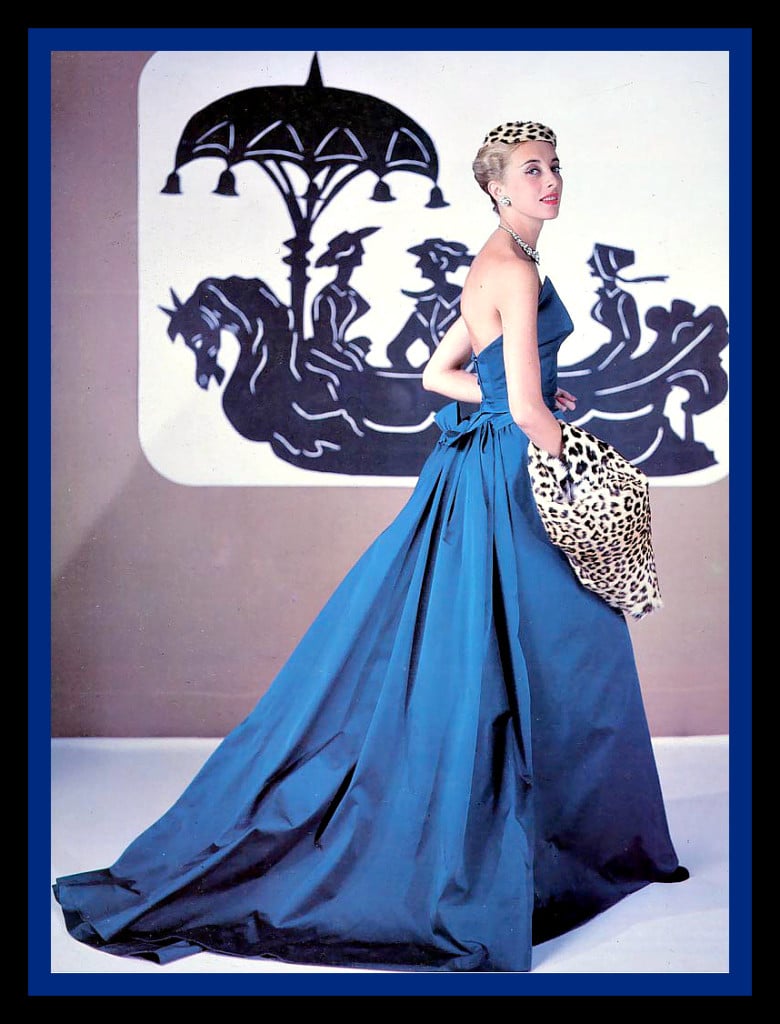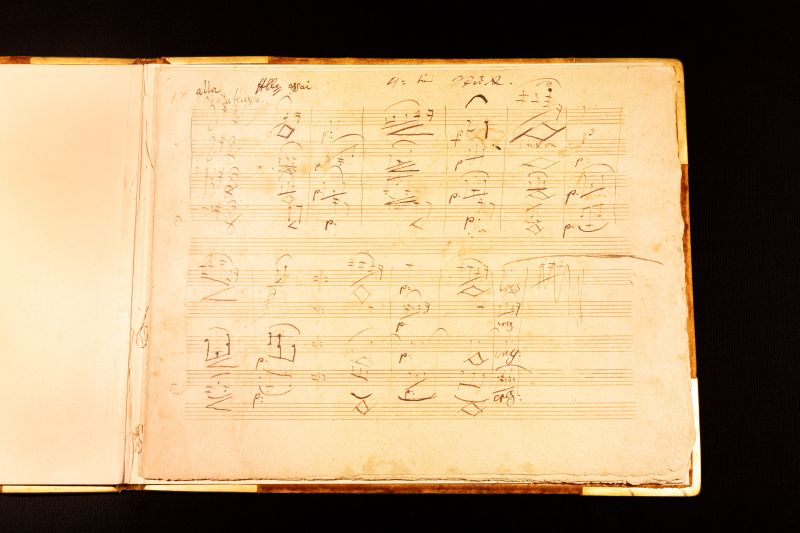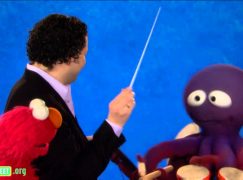10 ways to improve classical concerts
mainMike Vincent has come up with an achievable wishlist for improving the concert experience here on MusicalToronto.
We agree with most of his reforms.
Here’s a few more:
11 Allow drinks into the concert hall
12 Stop female soloists dressing like 1950s Hardy Amies mannequins. Dress normal, fffs sake.

13 Disperse critics around the hall, instead of cramming them into the top-price ghetto
14 Abolish agent-written artist biographies from programme booklets
15 Abolish printed booklets. Attach the content to online ticket bookings.
Any more?





Most concert halls I attend are not suitable for drinks — not enough leg room for clear passing by, and I’m afraid the old dodderers who make up the audiences are not really steady enough on their pins to be sure of squishing along to their seats without a danger of spilling.
Even if we are to be encouraged to come in jeans, we usually at least put clean clothes on when we go out, and I would resent spilt drink down a pair of jeans or a cotton shorts as much as down a silk evening dress. (To day nothing of sitting in sticky discomfort, and possibly leaving the hall reeking of some unconsumed alcohol). Can’t people go an hour without a drink of some sort?
On drinks… The opera hall here in Dallas permits drinks and serves them in non-spilling (plastic) sippy cups. It can be done.
On tuning… The Dallas Symphony has reduced tuning rituals to minimum. The whole complex is temperature controlled throughout so players can get tuned backstage with confidence. It’s been a long time since I’ve seen a soloist come out and tune on stage.
I disagree about the conductor walking onto the stage. It’s a signal that the concert is about to start. Otherwise how do people know?
Abolish fees to buy tickets. £3 online or £4 by phone – what’s that about? And yet it’s free in person. Basically: don’t put things in the way of somebody buying ticket.
Try different times – 6pm without an interval? But venues like the bar income…
I don’t think the conductor coming on stage is a bad tradition, nor the hand shaking thing. I could go either way with both of those. In general though, a good list. I would add to the point on tuning, how about stopping orchestra members practicing bits of what they’re about to play on the stage when the audience is in. That’s always seemed very sloppy to me.
I enjoy the tuning up as a part of the anticipation of the music and i also enjoy the instrumental “snippets” of tricky passages to come, etc. All part of the ambience. I could certainly do without the farcical handshaking but it doesn’t bother me more than that.
I hate the service charges for buying tickets, too. But it’s a way to earn more revenue, and these organizations all need more revenue, so those charges probably aren’t going away.
At the Chicago Symphony, the $5 fee applies to any ticket bought in person, too. The only way to avoid the fee is to buy a full season package.
That’s disgusting, and fraudulent. If these fees are entirely unavoidable to the single (or even partial subscription) ticket buyer, they should be included in the face value of the ticket. If they want to offer a discount to full-season subscribers they can cut $5 out of each ticket’s price.
Way to cultivate audiences: tick them off whenever you can. What a bunch of sneaky bastards. They wear Chicago’s mobster legacy well.
A rather unambitious and partly incongruous list, I thought. Applause between movements is fine, but watch your standing ovations? I mean, sure, if someone wants to applaud/stand, it’s a free country, but other people too are entitled not to applaud/stand. Then it’s just a matter of group dynamics, and, liberals that we are, we can afford to let that take care of itself. If you want to applaud, accept the risk that you may be the lone clapper. If there’s more of you, more power to you all, and so on.
Some other recommendations just show a poor understanding of how things work. Tuning onstage is not a necessity, but it’s useful. It’s also decent fun for newcomers, though I’m going by anecdotal evidence. Musicians often tune on stage in other genres, but an orchestra tuning sounds different to anything else. Feature, not bug.
Same with the concertmaster handshake. Concertmasters are a lot more important (and have to put in great amounts of work, long before the first rehearsal, e.g. marking accents etc) than the list acknowledges. If we explain the job to people, the purpose of the acknowledgement will become clear.
Orchestra/singers dress choices should be up to them. And they are pretty much up to them (though not as individuals as far as orchestra members are concerned)! Tradition is shaken up a lot more often that people realise.
All of Norman’s suggestions seem very reasonable and achievable. A couple more:
16. Encourage spoken introductions to pieces, preferably by the conductor.
17. Allow audiences to choose the repertoire for some concerts (e.g. by online vote; it’s already done in several places).
18. Programme at least one piece written in the 20th/21st century in every concert
19. Design seat rows to allow people to get in and out more easily, and less conspicuously.
Very interesting, but do you mean anything specific when you say a “20th / 21st century” piece? Just looked through the 16-17 brochure for our local (UK) symphony orchestra and actually it’s hard to find a concert that doesn’t feature 20th century music. Elgar, Mahler, Sibelius, Shostakovich, Rachmaninoff, Janacek, Vaughan Williams, Prokofiev, Barber, Copland, Gershwin, Walton, Richard Strauss, Debussy, Ravel…these are absolute core repertoire these days. Only 11 out of nearly 70 concerts don’t feature 20th or 21st century music. Actually, C18th music is far more scarce.
Please no to the conductor introducing the piece. I have come for the music not to hear him talk. Only exception should be encores.
I see your point. However, the audiences seem to like it (our audiences anyway), and we do want them to keep coming back. Sometimes the conductor even comes up with something interesting that’s not in the program notes.
Tuning onstage is surely necessary to a certain extent (but definitely not as sometimes happens by playing part of the repertoire about to be performed!) if ony because temperature and humidity control may be dufferent backstage.
As for drinks during concerts, as V.Lind suggests there is the possibility of spilling – plus surely also too much danger of glasses falling on to wood floors, or is the intention that wine and spirits are to be served in plastic cups? I’m certainly against this for major concerts.
Here’s a crazy one: stop caring about what female soloists wear and concentrate on their music. Close your eyes if necessary. Most of the ones who clamour that ‘opera is music first and that stage productions don’t matter’ (in any discussion about opera productions, reinterpretations and directors) are the first to forget how female soloists play and concentrate on their looks and clothes.
Emil, I very much understand your point – but keep in mind that male soloists’ choice of concert wear is extremely restricted, and if they had (or took) as much freedom as female soloists do, their sartorial choices would attract just as much comment.
There is, of course, a reason that male soloists’ choice of concert wear is restricted: the idea that the focus should be kept on the music and not on the visual spectacle of the performer. That this should be true for men and not women has never made sense to me.
Men’s concert choices are restricted because, socially, men’s formal wear is restricted to black (or white). Nothing to do with music.
“Abolish printed booklets” – yeah, transfer the cost and inconvenience of printing to the paying public. Nothing enhances the concert experience like wrestling with a handful of loose A4 sheets! Very clever.
Do like we do in the US and give them away for free. Make up the cost of printing them by selling advertising. If it’s too much work to do all that in-house, contract it out to a company like Playbill.
Most UK orchestras subcontract the selling of advertising to the firm that prints the booklet. And then sell the booklet to the public, who are generally happy to pay. It’s a small but profitable income stream, and the sales suggest that audiences like them. Why give that up? I can understand arguments for making the content more colourful and lively, but I don’t understand this idea that there’s some sort of problem here that needs solving (still less by making the process less convenient for the audience).
The problem – at least for Americans, who complain about it after every trip they make to the UK that involved seeing a performance – is the fact of charging money for a printed program at all.
We think that, having charged us to attend a concert, a hall should not charge us a second time for the privilege of knowing whom and what we’ve paid to hear.
Market forces: people are happy to pay, so they do. It’s pretty much the case everywhere in the classical world apart from the USA, as far as I can tell (same in the theatre too, whether musical or “straight”; and major pop stars charge lots for programme books on their tours as well). The key is to make the booklet something worth having: it’s not just a listing of who’s performing and what (which is freely available in the marketing material; you wouldn’t have bought a ticket if you didn’t already know that – would you?).
People like having a souvenir, or something to read on the train home. The best concert and opera programmes in my collection are so informative and well-produced that I’ve kept them for years; they’re effectively mini-handbooks to the work and production in question (just last month I reread an essay in a programme from an ENO programme from 1994). For less than the price of a pint of beer, that’s not bad value. Do you get much in the way of added value in a Playbill programme (I’ve never seen one, but the archive copies I see online all look fairly generic)?
Tuning on stage is a MUST. The change in temperature and humidity from backstage to stage affects sensitive string instruments. Does the author really understand the classical world? Would he prefer 50 string players playing out of tune? For the record, I am a professional double bassist, and my string colleagues will back me up.
^ Your wind player colleagues would back you up too.
Well, this last weekend my wife and I paid $111 a seat to hear our local orchestra perform (not very well) a program consisting of two (2) works totaling some 65 minutes. Maybe they ought to start by giving the audience value for money.
I like performers to acknowledge the audience. Some orchestra members shuffle on, do their stuff without enthusiasm, and then chat to their desk partner during the applause. “Hey! Player!! Over here! We’re clapping you!” Other orchestras insist that everybody turns to face the audience, which seems polite and appropriate. Basically: look as if you enjoy putting on a performance for a paying public (or non-paying public, in fact).
I’m always amused by the marxist thinking that you can make culture more ‘accessible’ to the public; this almost always involves dumbing down existing customs and protocols. It’s never in the opposite direction. And if people show resistance they’re, what is it now? Doddery. As though a concert hall is a nursing home, when nothing could be further from the truth. These insults show the collective IQs of those amassed OUTSIDE – literally and metaphorically.
Sometimes it’s not dumbing down protocols. Sometimes it’s dropping protocols that no longer make much sense (or never did).
Do tell us about some of these protocols which ;don’t make sense’. Any cultural group will ritualize its own habits and protocols. Let’s not stop at classical music if we want to discuss what “makes no sense”.
I agree with the comments of Paul Davis here at SD.
White bow tie & tails don’t make sense. The music would not suffer if those went away.
A quick rundown of the original list, because my opinions are super important:
– Clapping between movements: fine. Clapping during movements: not fine. (Mr. Vincent doesn’t advocate this, but he does say “If it were me, I’d be clapping at the recapitulation.”) IMHO Tchaikovsky knew exactly what he was doing when he composed the 3rd movement of the 6th symphony.
– Cellphones: signal-jamming not necessary. People should be considerate though. Understand that your phone can be a nuisance for other people, and they are just as important as you are.
– Tuning on stage: Sorry Mr. Vincent, your suggestion is idiotic. He says “Everything you do on stage sends a message. So what is the message you send by tuning on stage?” Oh, I don’t know… maybe that we all want to make sure we’re in tune with each other so the music we’re about to play for you has a better chance of sounding good? Temperature and humidity affect tuning; it really is better to tune once everyone’s instrument has had a chance to get used to the hot lights.
– Shaking hands with the concertmaster: pointless old tradition. Dump it.
– Concerts with “emerging composers:” please stop being purposely obtuse, Mr. Vincent.
– Standing ovations: well they’ve pretty much lost their meaning. A seated ovation now means “we didn’t really like it, and we’re glad it’s over.”
– Coats with tails: Agree. Fancy-looking, but increasingly anachronistic. Also uncomfortable as hell if you’re trying to play an instrument.
– Contemporary music: not sure if he’s against it, or just against ghettoising it to the front of the program. I agree that sometimes a piece would be better served by being played just after intermission, before the big piece. (On another note, I’ve noticed that my orchestra doesn’t play overtures anymore. Le Nozze on children’s concerts, and Russlan & Ludmila on our outdoor Labor Day concert. I haven’t played the Academic Festival Overture since 1993.)
Sorry, that wasn’t actually very quick. Oh well. On to Norman’s list:
– Drinks in the concert hall: tricky. We’ve had a few cases of drunk people in the balcony falling down the stairs during a performance, and one or two shattered wineglasses (good acoustics are a double-edged sword).
– Female soloist dress: what would it take to not distract you, Norman? For me personally, the outfit makes an impression for a moment, then fades into the background once the performance starts.
– Disperse critics around the hall: I know I like the sound better up in the cheap seats. Would (some) critics be offended if they were not given a comp in the most expensive section?
– Agent-written artist bios: Possibly. One does get tired of reading that “So-and-so has been called ‘the greatest _____ of his generation’.” What should there be instead? People like to know a little something about the person.
– Abolish printed booklets: Bad idea. People need something to do with their hands, and something to look at if conversation (or their attention) lags, or if they’re sitting alone. Unless you’re in favor of increased cell phone use during concerts…?
– I like Emmanuel’s suggestions, although his #19 (space the rows of seating farther apart) is not practical unless you’re building a new hall with this in mind. The conductor talking between pieces, as a way of marking pauses in the program/allowing latecomers to be seated/etc, could easily take the place of leaving the stage & returning.
– Will Duffay’s suggestion to have players acknowledge the audience is a good one. We instituted this years ago, and it’s popular with the orchestra & audience alike. Lots of string players felt awkward, as it turned out, not being able to look at the people who were clapping for them. (As a wind player, I was already facing forward, so it didn’t change anything for me.)
People for whom classical concert hall manners are a barrier to enjoying the music, should not go to classical music concerts. As simple as that.
Bravo. Spot on. There are plenty of entertainments for those who want to dress way way down.
The trouble with standing ovations is that most people shorter than 6 feet tall can’t get to see the conductor and performers because they are blocked by the people standing in front of them.
If the conductor doesn’t walk on stage, how does the audience know when to start clapping? You’ve gotten rid of an essential applause cue, plus the nice drama of the walk. Also, for a youngish or inexperienced soloist, coming out with the conductor means you have moral support. And you know where to walk, if you suddenly go brain dead.
I do agree about standing ovations, but I don’t know how you discourage those. They come with a less experienced audience, it seems, just like clapping between movements.
Coats with tails: sorry, I’m in favor. Just like shaking hands with the concertmaster, it adds elegance. It’s a throwback – a nice one.
I agree that contemporary music should go anywhere on the program where the conductor, or whoever, feels like placing it. But the idea that the beginning of the program is automatically a ghetto is dumb. Sometimes people leave at intermission, which makes the second half of the program “a ghetto.”
Allowing drinks into the hall is idiotic. Imagine all the knocked over drinks, the sticky floors, the wet upholstery, the slurping noises, the belching. It’s bad enough sitting in concerts where people are wrestling with candy wrappers and plastic bags.
The only change I want for concerts is for people to SHUT UP. Stop whispering – everyone except the deafest can still hear you. Stop groping around in your bag for things. Stop coughing. Stop dropping things on the floor.
Conductor walking onstage at the beginning of the concert: yes, absolutely. Then s/he would stay onstage and introduce each piece while the orchestra readjusted (rolling the piano onstage, or letting the trombones leave, or whatever).
The tailcoats have been a thorn in my side since I first had to wear one. Maybe there’s something wrong with me or there’s a special kind I never knew about, but I would never wear one again if I didn’t have to. Ever. (That’s one area where female musicians have an advantage: in an orchestra you can wear anything you like as long as it’s black and conforms to the dress code. It doesn’t have to be hot and uncomfortable. As a soloist you can wear anything you like, period.) I understand that they are fun to look at and provide a degree of visual uniformity, but I dislike them to the core of my being.
As for artist bios, they should all be written like Khatia Buniatishvili’s.
http://www.khatiabuniatishvili.com/about/
Wow. That’s… amazing.
BTW, I don’t think the separate concertmaster entrance is necessary. His/her chair and position in the orchestra already show the importance of the concertmaster. As far as letting the audience know the concert is about to begin, turning the lights down and the orchestra tuning is enough. And definitely no need to repeat the process for the second half of the show.
“Letting the audience know the concert is about to begin” is an alternate way of saying, “OK, time to shut the eff up!” The stage entrances, the mass tunings, etc give those audiences members who have such very, very important things to say to their seat mates, a couple of extra moments to wrap it up and put a cork in it.
Keep all that stuff, especially after the interval, since a couple drinks in them and it’s even harder for them to control their traps.
“I don’t think the separate concertmaster entrance is necessary.”
While there are bound to be orchestras that do this, I personally know it mostly from some German orchestras (i.e. Gewandhausorchester, Staatskapelle Dresden & Berlin, Konzerthausorchester Berlin). All musicians come onstage together and remain standing until everybody makes it to their stand, then sit down and tune.
People are actually complaining about the 3 seconds it takes for the conductor to shake the concertmaster’s hand.
It’s not the 3 seconds, it’s the pointlessness (real or not).
Most of the suggestions will not “improve” the classical concert and attempting to make it more approachable brings its own risks. At a Prom last year, the music was repeatedly ruined for dozens by rowdy behaviour of a young group with drinks. Attracted by dumbdown publicity they were amazed that they’d caused any damage: “What do you expect when you pay only five pounds…? (!)”
Personally i have a horror of spoken introductions; words are never equal to the music, exception made for many contemporary offerings where the words, unfortunately are superior to the subsequent noises.
Formal dress should certainly be relaxed; it’s absurd that players should still suffer tails and ties. Many summer festivals i attend have smartly dressed orchestras with open-necked dark shirts, (or of any shade as long as it’s uniform). All credit to Vladimir Ashkenazy for personally abolishing the tie, replaced in his case by the polo-neck; among other solutions might be the chinese-style collar…..
Anyone who appreciates symphonic works will find applause between movements most destructive to mood, flow and cohesion. Why is this considered so difficult?
I enjoy the tuning-up before the concert and so do many newcomers i’ve spoken to. I can’t think why this is considered an obstacle. The conductor has to walk on at some stage so why not when everything is ready? That’s also part of the pleasurable anticipation. The handshake seems superfluous and i could willingly forgo it, but it doesn’t bother me terribly and takes no time so, not many changes needed.
Many people wanting to “improve” things have obviously little love of or desire to know the music in question. If they wish to applaud a-gogo, slurp and burp, take selfies, and listen to exaggerated descriptions and bootlicking bios…..(etc) let them stay with TV chat shows, much easier!
Pretty good takedown of lists like this, from Throwcase: http://www.throwcase.com/2016/06/06/change-classical-music/
I don’t like the chorus standing mutely onstage through the first three movements of Beethoven’s ninth symphony. That must be awfully tiring for them as well as distracting for the audience. Much more dramatic if they file quietly onstage while the orchestra tunes for the last movement. But then I’ve seen few performances of the ninth.